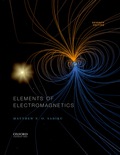
Concept explainers
Calculate the global coefficient matrix of the two element region.
Answer to Problem 27P
The global coefficient matrix is
Explanation of Solution
Calculation:
Refer to Figure 14-60 in the textbook for the two-element region.
For element 1, local numbering 1-2-3 corresponds to global numbering 4-2-1.
From Figure 14.60, the given values are,
Calculate the value of
Calculate the value of
Calculate the value of
Calculate the value of
Calculate the value of
Calculate the value of
Consider the expression for the area A.
Substitute 0 for
Write the expression for co-efficient
By using Equation (2), the coefficient values
Write the expression of the element coefficient matrix C.
Substitute 0.7969 for
For element 2, local numbering 1-2-3 corresponds to global numbering 2-4-3.
From Figure 14.60, the given values are,
Calculate the value of
Calculate the value of
Calculate the value of
Calculate the value of
Calculate the value of
Calculate the value of
Substitute 0 for
By using Equation (2), the coefficient values
Write the expression of the element coefficient matrix C.
Substitute 1.2 for
Calculate the global coefficient matrix.
Conclusion:
Thus, the global coefficient matrix is
Want to see more full solutions like this?
Chapter 14 Solutions
Elements of Electromagnetics
- Calculate the entropy change for 1.00 mol of an ideal gas expanding isothermally from a volume of 24.4 L to 48.8 L.arrow_forwardDetermine the endurance limit.arrow_forwardWater enters an adiabatic nozzle steadily at 500 kPa and 300˚C with a mass flow rate of 6000 kg/h and leaves at 100 kPa and 45 m/s. The inlet area of the nozzle is 40 cm2. Take the Cp of CO2 to be 4.2 kJ/kgK and the specific volume of water to 0.001 m3/kg. Determine the inlet velocity and the exit temperature.arrow_forward
- Water enters the constant 130 mm inside-diameter tubes of a boiler at 7 MPa and 65˚C and leaves the tubes at 6 MPa and 450˚C with a velocity of 80 m/s. Calculate the velocity of the water at the tube inlet and the inlet volume flow rate. Hint: the mass flow rate remains constant.arrow_forwardQ1: A. One of the researchers discovered a patent related to the development of a certain software module in mobile devices, and when he emailed one of the companies producing these devices, they asked him to send the research to try it on their devices, and after a while this researcher discovered that his discovery was used by this company without referring to him or buying this discovery, What do you think about the above. B. As a quality control engineer in one of the electrical appliance factories, I discovered that the technical worker responsible for inspecting one of these products seals its validity without inspecting it. when I filed a complaint with the administration, the administration neglected the complaint, arguing that there was no time to inspect it again due to lack of time to prepare the consumer. 1. What are the consequences of this action, it is possible that there is a bad in the product due to lack of examination. 2. The actions that you should take because of…arrow_forwardThe pump shown in figure delivers water from the lower to the upper reservoir at arate of 2 cfs. The energy loss between suction inlet and the pump is 6 lbf-ft/lbf and betweenthe pump outlet and the upper reservoir is 12 lbf-ft/lbf . Both pipes are 6-inch schedule 40steel pipe. Calculate (a) the total head on the pump and (b) the power delivered by the pumpto the waterarrow_forward
- 4. Now consider the figure below showing a wooden block subjected to biaxial loading, and its stress state in the laboratory coordinate system. The grain in the wood is aligned at an angle of 15° to the vertical direction as shown. Determine the stress state in the orientation of the grain. Y σy = 1.8 MPa 15° σx = 3 MPa ох ==arrow_forwardplease hand-written solution only!arrow_forwardhand-written solution only please!arrow_forward
- handwritten solutions only, please!arrow_forwardOn from the equation: 2 u = C₁ + C₂ Y + Czy + Cu y³ Find C₁, C₂, C3 and Cy Using these following Cases : (a) 4=0 at y=0 (b) U = U∞ at y = 8 du (c) at Y = S ду --y. ди = 0 at y = 0 бугarrow_forwardI need help with a MATLAB code. I am trying to solve this question. Based on the Mars powered landing scenariosolve Eq. (14) via convex programming. Report the consumed fuel, and discuss the results with relevant plots. I am using the following MATLAB code and getting an error. I tried to fix the error and I get another one saying something about log and exp not being convex. Can you help fix my code and make sure it works. The error is CVX Warning: Models involving "log" or other functions in the log, exp, and entropy family are solved using an experimental successive approximation method. This method is slower and less reliable than the method CVX employs for other models. Please see the section of the user's guide entitled The successive approximation method for more details about the approach, and for instructions on how to suppress this warning message in the future.Error using .* (line 173)Disciplined convex programming error: Cannot perform the operation:…arrow_forward
 Elements Of ElectromagneticsMechanical EngineeringISBN:9780190698614Author:Sadiku, Matthew N. O.Publisher:Oxford University Press
Elements Of ElectromagneticsMechanical EngineeringISBN:9780190698614Author:Sadiku, Matthew N. O.Publisher:Oxford University Press Mechanics of Materials (10th Edition)Mechanical EngineeringISBN:9780134319650Author:Russell C. HibbelerPublisher:PEARSON
Mechanics of Materials (10th Edition)Mechanical EngineeringISBN:9780134319650Author:Russell C. HibbelerPublisher:PEARSON Thermodynamics: An Engineering ApproachMechanical EngineeringISBN:9781259822674Author:Yunus A. Cengel Dr., Michael A. BolesPublisher:McGraw-Hill Education
Thermodynamics: An Engineering ApproachMechanical EngineeringISBN:9781259822674Author:Yunus A. Cengel Dr., Michael A. BolesPublisher:McGraw-Hill Education Control Systems EngineeringMechanical EngineeringISBN:9781118170519Author:Norman S. NisePublisher:WILEY
Control Systems EngineeringMechanical EngineeringISBN:9781118170519Author:Norman S. NisePublisher:WILEY Mechanics of Materials (MindTap Course List)Mechanical EngineeringISBN:9781337093347Author:Barry J. Goodno, James M. GerePublisher:Cengage Learning
Mechanics of Materials (MindTap Course List)Mechanical EngineeringISBN:9781337093347Author:Barry J. Goodno, James M. GerePublisher:Cengage Learning Engineering Mechanics: StaticsMechanical EngineeringISBN:9781118807330Author:James L. Meriam, L. G. Kraige, J. N. BoltonPublisher:WILEY
Engineering Mechanics: StaticsMechanical EngineeringISBN:9781118807330Author:James L. Meriam, L. G. Kraige, J. N. BoltonPublisher:WILEY





